Written by: Nancy, PANews
Recently, the MEME market sentiment has gradually warmed up, especially with the drive of multiple large MC memecoin projects, significantly improving the overall market activity. However, the MEME ecosystem is still in the early stages of recovery, and capital confidence has not yet been fully restored. Meanwhile, under the background of insufficient liquidity and high emotional sensitivity, the head effect is gradually becoming the core driver of traffic and capital, especially with the synergistic effect of platforms and tools further amplifying the market influence of the head, making it a key variable for capital flow and sentiment fluctuations.
Launchpad: Significant Head Effect, Driving Emerging Platforms
Although the MEME market has warmed up, from the perspective of token creation quantity and user activity, it is still far from the historical peak.
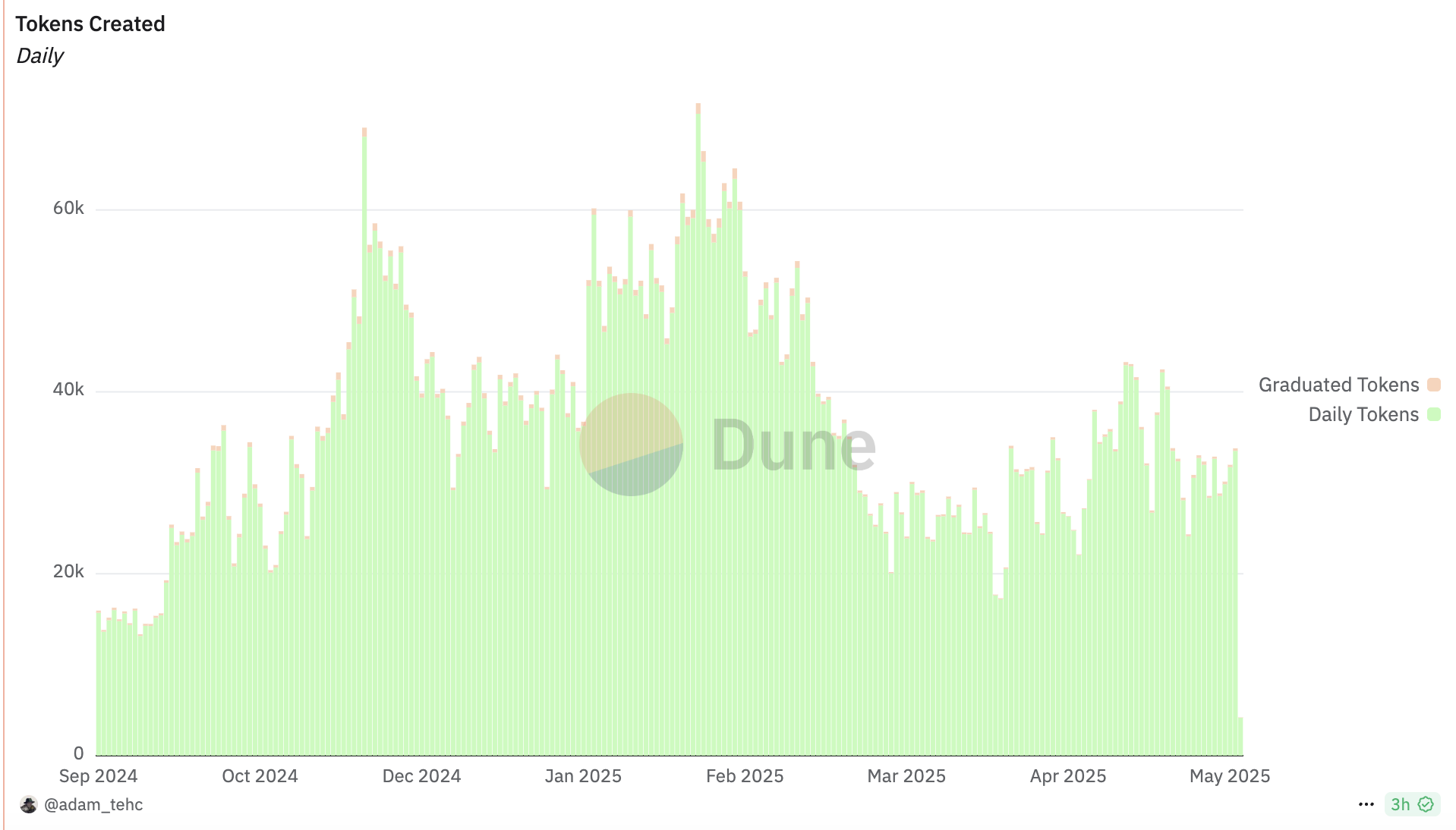
Taking the current MEME coin launch main base Pump.fun as an example, according to Dune data, as of May 7, the platform's daily token creation volume has exceeded 33,000, an increase of 48.6% from the previous low point (about 17,000), but still only 47.5% of the historical peak. In terms of token graduation rate, it has now rebounded to 0.81%, which is a significant improvement from the lowest point, but still far from the historical high of 1.67%. In terms of user activity, Pump.fun's current daily active wallets reached 199,000, a rebound of 55.1% from the previous month's low point, but only 46.9% of the historical peak (about 424,000). It is worth noting that from the perspective of new users, the current daily new wallets are about 94,000, which is still limited compared to the historical peak of over 216,000. This means that although the MEME heat has obviously warmed up in the short term, the overall user participation and liquidity breadth have not been fully restored.
However, some emerging token launch platforms have also rapidly expanded by leveraging the head effect. For example, the recently popular Boop successfully used the head effect to achieve user growth and market value leap in the short term through KOL-driven FOMO effect, platform incentive mechanisms, and precise market rhythm control. However, this method also faces challenges such as short-term retention issues caused by KOL airdrops and competitive pressure from potential strategy replication by competitors.
It is worth mentioning that several recently hyped "large MC memecoin" projects have shown significant head effects, where high-influence figures like KOLs and large holders drive traffic and capital inflow, forming a snowball-like spread that further amplifies the token narrative value. For example, large holders collectively pushed Fartcoin's market value to over $1 billion, and House gained momentum with support from famous KOLs like ansem and him. In contrast, recent MEME coins relying on event-driven or grassroots narratives, although able to attract short-term attention, find it difficult to convert traffic into effective capital inflow, leading to rapid heat decline.
Trading Robots: Trading Volume Rebounds, Still Down Nearly 90% from Peak
Trading robots are gradually becoming an important tool for on-chain users to improve trading efficiency, and have recently rebounded with market sentiment. Dune data shows that as of May 6, the daily trading volume of trading robots reached $85.37 million, with daily users exceeding 57,000, respectively rising nearly 64.1% and 43.8% from recent low points. However, compared to the peak in January this year, daily trading volume and daily users have still dropped by 89.1% and 62.5% respectively.
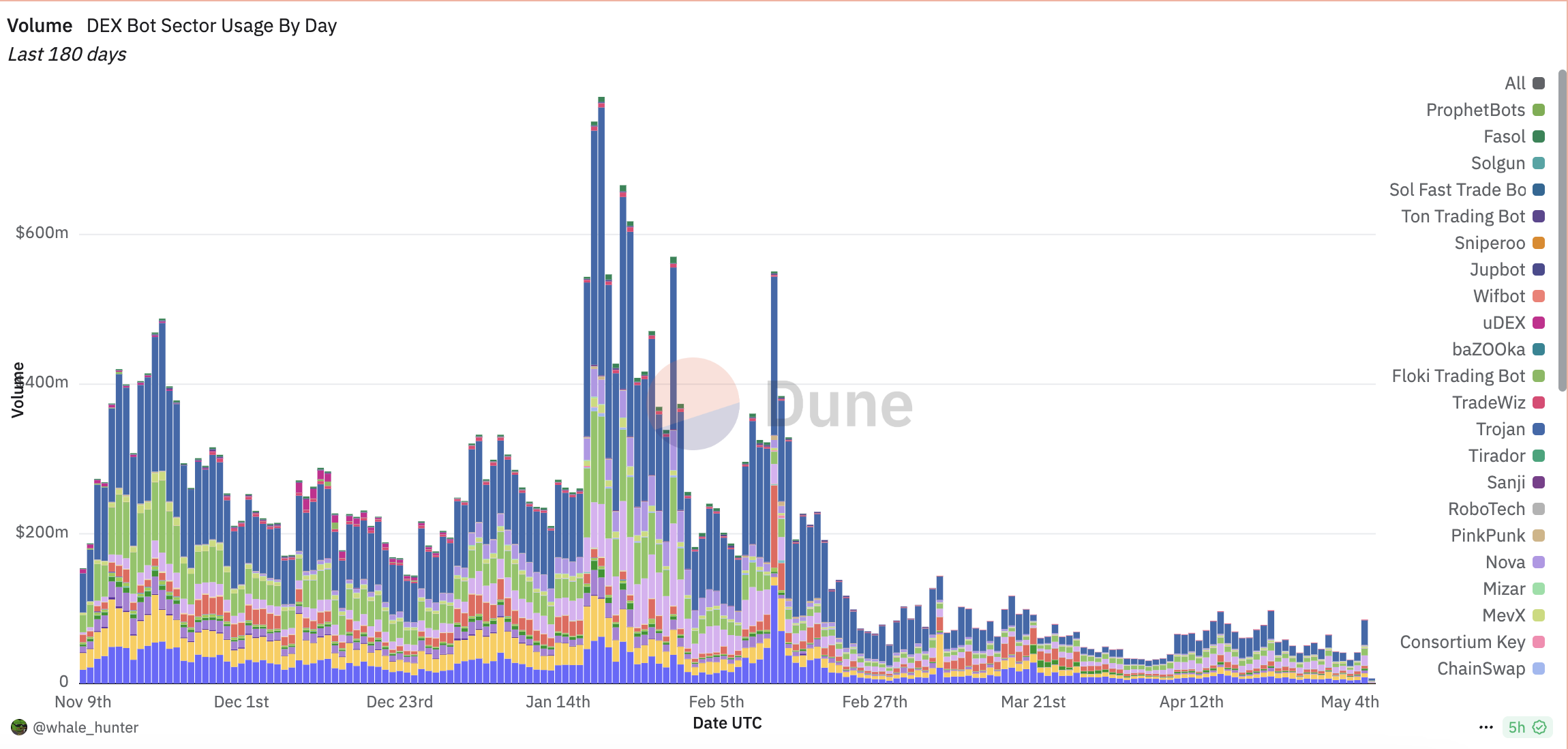
In fact, for ordinary retail investors, the functions of trading robots such as smart money tracking, automated follow-up trading, and on-chain data analysis can help them real-time monitor and quickly capture KOL/large holder dynamics in an information asymmetry market environment, effectively improving participation efficiency and reducing PVP risks.
Meanwhile, retail investors often hold high trust in trading robots recommended or used by heads, and this endorsement effect significantly improves the market acceptance and activity of related robots. Of course, heads, due to their capital volume and market appeal, are more inclined to use robots with characteristics such as convenient operation, fast execution speed, and high success rate to ensure trading efficiency and maximize returns. Therefore, whether trading robots can meet demands in terms of functional diversity, security, or response speed is a core factor affecting heads' willingness to use them. Of course, the potential risk of market manipulation by some heads through robots cannot be ruled out.
For example, the recently emerging Axiom quickly became the leader in the trading robot track in the short term by virtue of its complex strategy support, efficient trading execution, and user-friendly design, especially by meeting the core needs of heads (KOLs/large holders).
DEX: MEME Revenue Plummets, PumpSwap Shows Initial Advantages
MEME remains one of the core sources of DEX revenue. Taking Raydium as an example, Blockworks data shows that in the past 30 days of trading revenue, the daily revenue from MEME-related transactions accounted for as high as 86.8%, and the daily revenue from MEME token issuance reached 93.5%, demonstrating its dominant position in the platform's overall revenue structure.
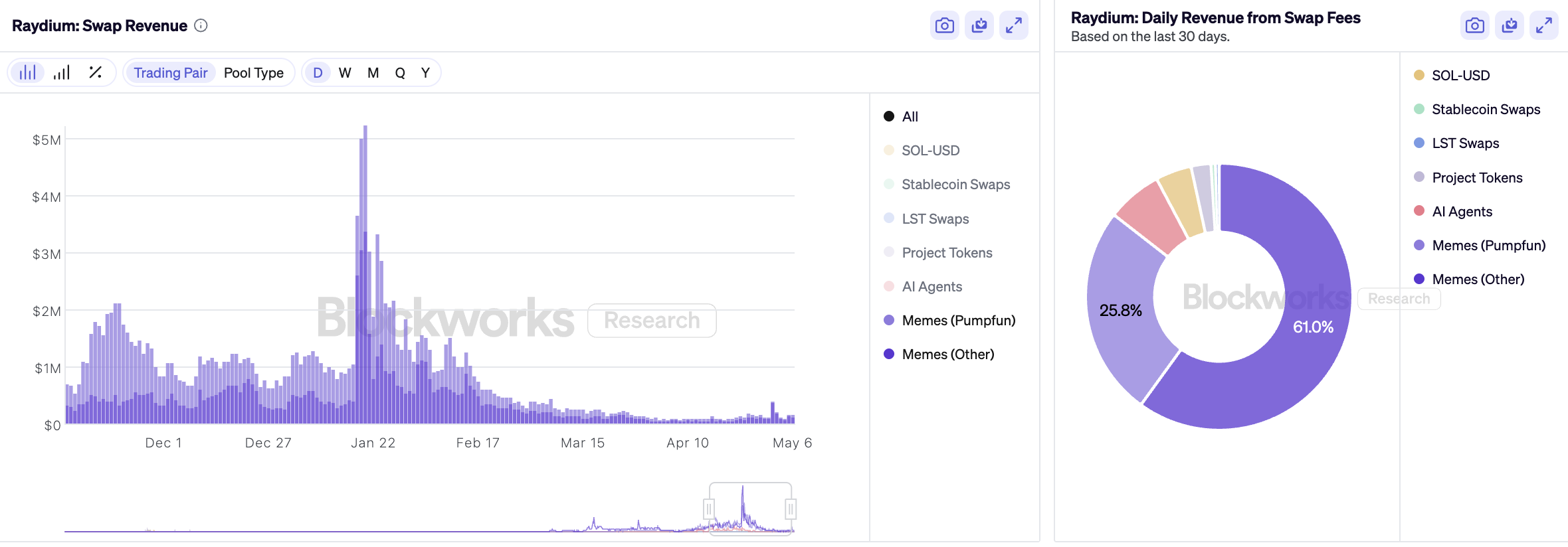
However, the revenue brought by MEME is experiencing a significant decline. Blockworks data shows that as of May 6, Raydium's daily trading revenue from MEME was only $156,000, a drop of over 97% from the January peak of $5.244 million. At the same time, the daily revenue from MEME coin issuance has also dropped from the high point of $149,000 to just $19,000, showing the rapid cooling of market heat and the obvious retreat of user speculative sentiment.
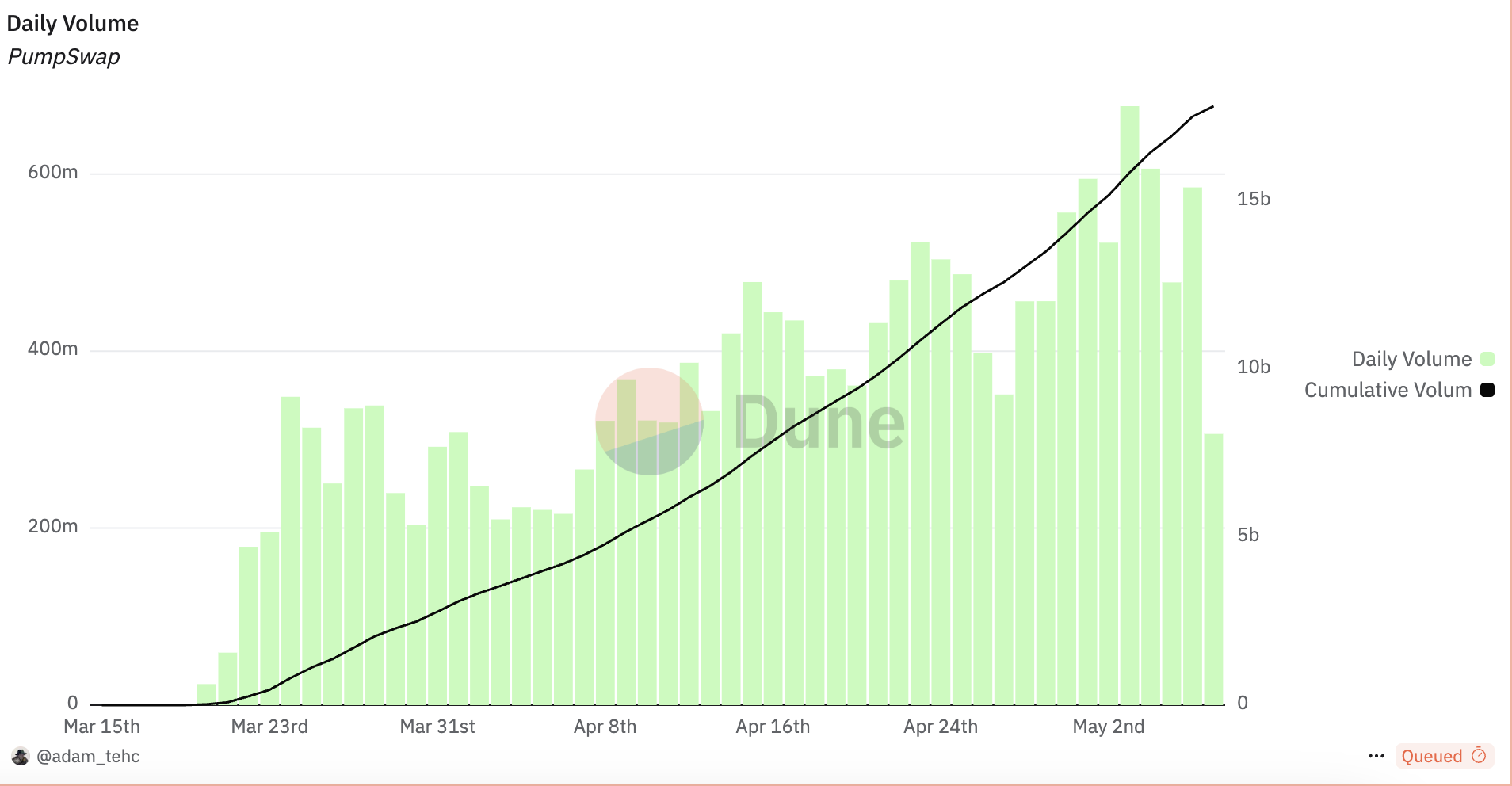
In contrast, PumpSwap has shown strong momentum. Dune data shows that since its launch on March 20, the platform has accumulated a trading volume of $17.67 billion, and has shown a significant upward trend since early April, with a single-day maximum trading volume of over $670 million. At the same time, the platform's user activity has continued to rise, quickly attracting many new users during the cold start phase, with the return user ratio gradually increasing, showing strong user retention capabilities. Notably, in early May, its daily active wallets once exceeded 450,000. As of May 7, PumpSwap has occupied 12.7% of the total trading volume of Solana DEX, gaining an initial competitive advantage in the ecosystem.
In this process, the role of large holders/KOLs cannot be ignored, not only driving significant growth in MEME trading volume but also driving rapid expansion of liquidity pools and concentrated influx of new users, becoming the core driving factor for the platform's short-term burst.
Wallets: Activity Rebounds, Down Over 80% from January Peak
Wallet usage is also an important indicator reflecting on-chain sentiment. Dune data shows that as of May 5, the weekly trading volume of mainstream wallets reached over $460 million, rebounding 35.2% from the recent low point, but only 51.6% of the peak this year (about $950 million). At the same time, the weekly active wallet addresses reached 17,000, a significant drop of over 80.4% from the January peak of 87,000. This indicates that although the trading scale has rebounded, user participation remains low, and the overall on-chain activity is still in the early stages of recovery, with market sentiment not yet fully warmed up.
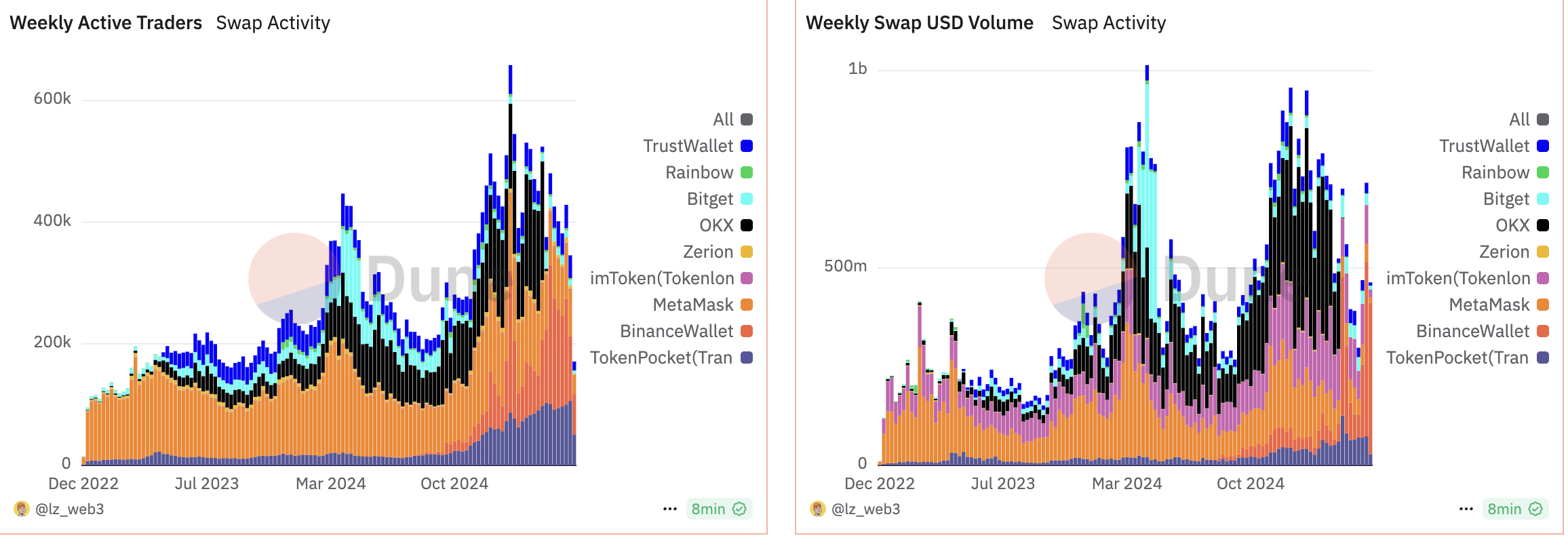
Similarly, the attractiveness and user stickiness of a wallet depend on core factors such as the completeness of its functions, the breadth of use cases, and the ability to integrate with the ecosystem. For example, OKX Web3 Wallet and Binance Wallet, which have high market shares, have successfully attracted a large number of MEME players and become the mainstream choice in this niche field. In this process, the usage rate and word-of-mouth effect of large investors and key opinion leaders have also played a crucial driving role, not only significantly improving the wallet's visibility but also enhancing the trust and willingness to use among ordinary users.







